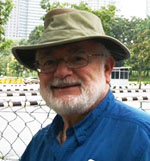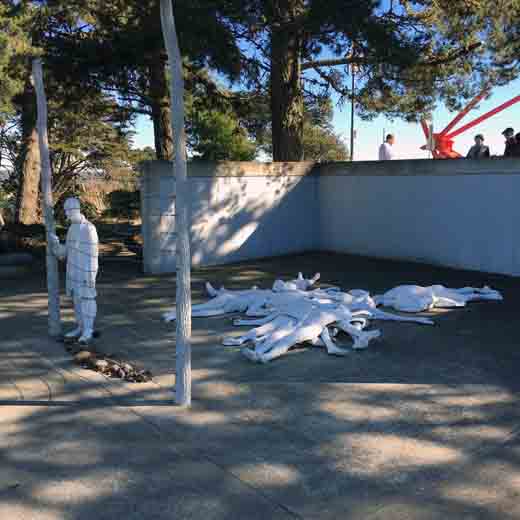Editor’s Note: This inaugurates a new series of stories where a Jewish writer searches out Jewish art in museums, galleries and libraries.
(c) Oliver B. Pollak

SAN FRANCISCO –We joined San Francisco’s De Young Museum and the Legion of Honor. On Thursday between Christmas and New Year we spent an afternoon at the much applauded exhibited of Viennese artist Gustav Klimt (1862-1918) and Parisian Auguste Rodin (1840-1917). Our introduction to Klimt were sensual posters in our 1960s college years. We vividly remember visiting the Rodin museum in Paris in 1970.
Klimt was Catholic; many of his models were Jewish as were his patrons. And of course the Nazi theft of Jewish art and the disruption of provenance made the 2015 movie Woman in Gold and the 2014 film, The Monuments Men a wide success. Rodin was Catholic and had Jewish patrons.
But the real Jewish experience occurred before we entered the museum. Walking from where parked on the street we came upon the Holocaust Memorial, public art that has stood here for 33 years at the corner of the parking lot with a view of the Museum and the Golden Gate Bridge.
California and New York each have seven Holocaust memorials. Synagogues, Temples, Jewish Community Centers, Jewish day schools, public and private libraries and art galleries with serious Holocaust collections comprise further memorials, as does the permanent flickering light in many Jewish homes. Yom HaShoah, Holocaust Remembrance Day, inaugurated in 1953, is observed on the 27th day of Nisan (April/May).
San Francisco organized a competition for a Holocaust Memorial in 1981. George Segal got a letter from Mayor Dianne Feinstein asking him to submit a drawing or a maquette. Segal (1924-2000) won the competition with a plaster, wood, and wire sculpture. It was installed in 1984. Unfortunately, the pile of bodies has become far too familiar in more recent genocides, atrocities and shootings in schools, concerts, night clubs and churches.
Segal wrote on a tablet above the installation, “We will never forget the martyrdom of that evil abyss in human history. Nor will we forget those Jews and the righteous of all faiths, who resisted and fought that evil.” The victims on the ground exhibit terror. In the back comfort is is seen in a hand stroking a cheek. I do not know if it was Segal’s intention for pine cones, large stones, and small stones that adorn Jewish graves to be under the barbed wire fence. The barbed wire casts a shadow on the ground. If he picked up his gaze, he would see the natural wonder of the Golden Gate and the Marin Headlands.
The Klimt Rodin exhibit was wonderful. On my next visit I will excavate Jewish art inside the museum.
*
Oliver B. Pollak is a freelance writer who moved in 2016 to Richmond, California. He lived in Omaha, Nebraska for 42 years and is Emeritus Professor of History at the University of Nebraska at Omaha. He practiced law for 33 years and is the author of over ten books and 650 scholarly and popular articles.
